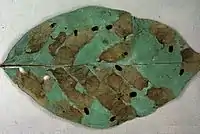| Antispila nysaefoliella | |
|---|---|
| Scientific classification | |
| Domain: | Eukaryota |
| Kingdom: | Animalia |
| Phylum: | Arthropoda |
| Class: | Insecta |
| Order: | Lepidoptera |
| Family: | Heliozelidae |
| Genus: | Antispila |
| Species: | A. nysaefoliella |
| Binomial name | |
| Antispila nysaefoliella | |
| Synonyms | |
| |
Antispila nysaefoliella (tupelo leafminer moth) is a species of moth of the family Heliozelidae. It is found in south-eastern North America.

The wingspan is about 8 mm. Adults are on wing in spring.
The larvae feed on Nyssa sylvatica. They mine the leaves of their host plant. The mine is blotch-shaped and tends to expand radially and typically becomes more oblong-shaped at later instars. The larva feeds with its dorsal side facing the lower leaf surface.[2] Low (2008) observed that the larvae are able to make sounds using sclerotized structures on their dorsum and tail.[2] The last instars form an oval-shaped double-sided shield by encasing themselves with silk between the upper and lower mine layers. They then cut the shield and descend into the leaf litter for pupation.[3] Larvae can be found from late August to early September.
References
- ↑ mothphotographersgroup
- 1 2 Low, Candace (2008). "Seismic Behaviors of a Leafminer, Antispila nysaefoliella (Lepidoptera: Heliozelidae)". Florida Entomologist. 91 (4): 604–609. doi:10.1653/0015-4040-91.4.604.
- ↑ Low, Candace. "Natural History of the Tupelo Leafminer". Cornell University. Archived from the original on 21 August 2016.